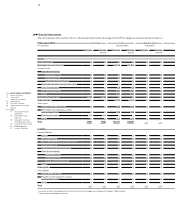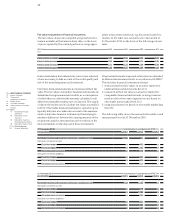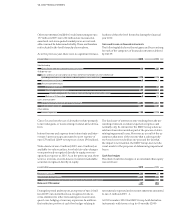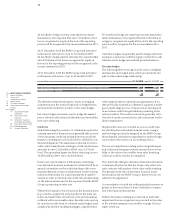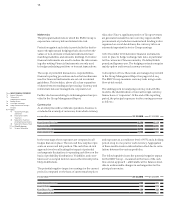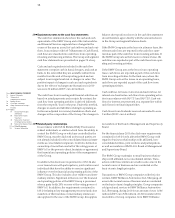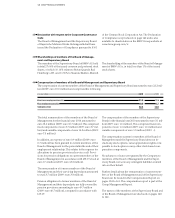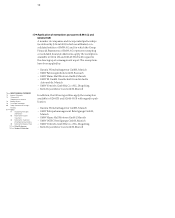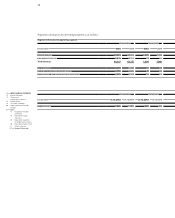BMW 2010 Annual Report Download - page 126
Download and view the complete annual report
Please find page 126 of the 2010 BMW annual report below. You can navigate through the pages in the report by either clicking on the pages listed below, or by using the keyword search tool below to find specific information within the annual report.
124
74 GROUP FINANCIAL STATEMENTS
74 Income Statements
74 Statement of
Comprehensive Income
76 Balance Sheets
78 Cash Flow Statements
80 Group Statement of Changes
in Equity
81 Notes
81 Accounting Principles
and Policies
89 Notes to the Income
Statement
95 Notes to the Statement
of Comprehensive Income
96 Notes to the Balance Sheet
117 Other Disclosures
133 Segment Information
46months) to hedge currency risks attached to future
transactions. It is expected that euro 110 million of net
losses, recognised in equity at the end of the reporting
period, will be recognised in the income statement in 2011.
At 31 December 2010 the BMW Group held derivative
instruments with terms of up to 72 months (2009:
84months) to hedge interest rate risks. It is expected that
euro 42 million of net losses, recognised in equity at
theend of the reporting period, will be recognised in the
income statement in 2011.
At 31 December 2010 the BMW Group held derivative
instruments with terms of up to 35 months (2009:
The difference between the gains / losses on hedging
instruments and the result recognised on hedged items
represents the ineffective portion of fair value hedges.
Fair value hedges are mainly used to hedge the market
prices of bonds, other financial liabilities and receivables
from sales financing.
Credit risk
Notwithstanding the existence of collateral accepted, the
carrying amounts of financial assets generally take account
of the maximum credit risk arising from the possibility
that the counterparties will not be able to fulfil their con-
tractual obligations. The maximum credit risk for irrevo-
cable credit commitments relating to credit card business
amounts to euro 1,020 million (2009: euro 1,513 mil-
lion).
The equivalent figure for dealer financing is euro
14,388 million (2009: euro 12,634 million).
In the case of performance relationships underlying
non-derivative financial instruments, collateral will be re-
quired, information on the credit-standing of the coun-
terparty obtained or historical data based on the existing
business relationship (i.e. payment patterns to date) re-
viewed in order to minimise the credit risk, all depending
on the nature and amount of the exposure that the BMW
Group is proposing to enter into.
Within the financial services business, the financed items
(e.g. vehicles, equipment and property) in the retail cus-
tomer and dealer lines of business serve as first-ranking
collateral with a recoverable value. Security is also put up
by customers in the form of collateral asset pledges, asset
assignment and first-ranking mortgages, supplemented
35months) to hedge raw material price risks attached to
future transactions. It is expected that euro 88 million of
net gains, recognised in equity at the end of the reporting
period, will be recognised in the income statement in
2011.
Cash flow hedges are generally used to hedge cash flows
arising in conjunction with the supply of vehicles to sub-
sidiaries and to hedge raw material price fluctuations.
Fair value hedges
The following table shows gains and losses on hedging
instruments and hedged items which are deemed to be
part of a fair value hedge relationship:
where appropriate by warranties and guarantees. If an
item previously accepted as collateral is acquired, it under-
goes
a multi-stage process of repossession and disposal
in accordance with the legal situation prevailing in the
relevant market. The assets involved are generally vehi-
cles which can be converted into cash at any time via the
dealer organisation.
Impairment losses are recorded as soon as credit risks
are
identified on individual financial assets, using a
methodology specifically designed by the BMW Group.
More detailed information regarding this methodology
is provided in the section on accounting policies.
The use of comprehensive rating and scoring techniques
and credit monitoring procedures ensures the
recovera-
bility of the value of receivables from sales financing
which
are neither overdue nor impaired.
The credit risk relating to derivative financial instruments
is minimised by the fact that the Group only enters into
such contracts with parties of first-class credit standing.
The general credit risk on derivative financial instru-
ments utilised by the BMW Group is therefore not con-
sidered to be significant.
A concentration of credit risk with particular borrowers or
groups of borrowers has not been identified in conjunc-
tion with financial instruments.
Further disclosures relating to credit risk, in particular
impairment losses recognised, are provided in the notes
to the relevant category of receivables on page 102 and
pages 104 et seq.
in euro million 31. 12. 2010 31. 12. 2009
Gains / losses on hedging instruments designated as part of a fair value hedge relationship – 808 – 398
Gains / loss from hedged items 763 446
– 45 48






